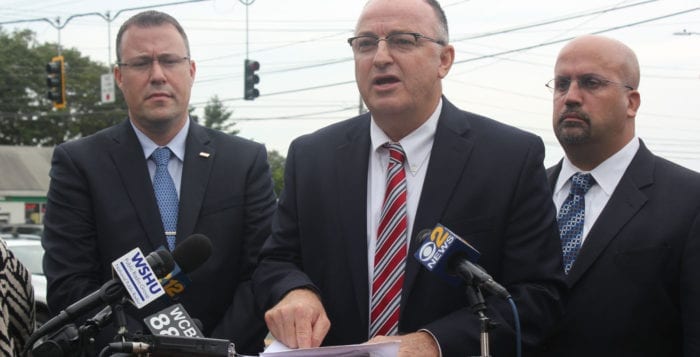Students in Mount Sinai are expected to grow up a little faster than those in other districts. While a majority of neighboring towns keep their fifth-graders in the elementary school, Mount Sinai, since the early 1990s, moves its 10- and 11-year-olds up to the middle school.
A mother challenged the concept during an Aug. 23 board of education meeting when she asked administrators to consider making fifth grade part of the elementary school again in the future.
The conversation has been ongoing ever since.
Renee Massari, a mother of two elementary school students, proposed the idea last month, saying she didn’t see the academic or social benefit of having fifth-graders learn under the same roof as eighth-graders. In fact, she believed the drastically different environment negatively affected the young students — who occupy their own wing on the second floor of the building.
“I’ve seen it through many of my friends’ children here — many of them don’t excel.”
—Renee Massari
“I’ve seen it through many of my friends’ children here — many of them don’t excel,” Massari said during the meeting. “It’s almost like they feel deflated because it’s difficult for them to handle those responsibilities expected of our fifth-graders. Because [realistically], they aren’t middle schoolers.”
Massari explained to the board that, from her understanding, the fifth-graders’ premature graduation to the middle school was prompted solely by a lack of classroom space in the elementary school. She asked if an administrator could evaluate current classroom space, adding the school has seen a declining enrollment rate over the last few years.
“Ideally, I would love for the fifth-graders in this district to have the same transition that 99 percent of the districts on Long Island have,” Massari said. “We can house them in the elementary school, a building they’re familiar with, and keep the same program where they transition from classroom to classroom and get them exposed to that before going to a whole different building.”
Board Trustee Robert Sweeney agreed with Massari and said the decision decades ago to move the students into the next building had nothing to do with education and everything to do with space and misjudgment. He also urged the board to reevaluate the concept.
“It’s a fallacy to have elementary students up there,” Sweeney said. “I think we have to look at it because there’s no educational benefit [to it].”
Superintendent Gordon Brosdal, an admittedly “old school guy” who said he would even like to see the sixth grade in the elementary school, told Massari her proposal would be explored — but classroom space, or lack thereof, in the district’s smallest building remains an issue. He said it will take a lot more than one available classroom to bring back the fifth-graders to the elementary school and expansions on the building would be costly.

“But in the meantime, what we have to do is make sure the nurturing environment continues in the fifth grade,” Brosdal said.
Teachers, he said, know to treat their students with the same level of care and support elementary school students experience. And although the move up offers a completely new setting, with lockers and classroom changes and multiple teachers during the day, Brosdal sees it as a good transition opportunity.
“Plus, they’re kind of isolated and not mixing with the older grades when they don’t have to,” he said. “At the same time, I understand parents feel their kids are not ready to move up because of maturity and a lot of other reasons, and want them to remain in a nurturing environment.”
In the weeks following the meeting, Brosdal reached out to elementary school principal Rob Catlin, and together they projected six classrooms would be needed in the building to accommodate the roughly 175 students in the current fifth-grade class.
One would be hard-pressed to find three available classrooms, according to Catlin, who is currently in the process of meeting with parents about the issue.
“I’ve heard the same concerns from a couple different people now and I’m reaching out to some parents for some meetings to talk about it,” Catlin said. “As the year goes on, and if the topic continues, I’m more than happy to keep talking. But it’s in an early stage right now.”
Mount Sinai resident Beth Erdmann, whose children are in seventh and 10th grades, said every parent experiences panic in the midst of the elementary and middle school transition but soon realize it’s not a big deal.
“I’ve heard the same concerns from a couple different people now and I’m reaching out to some parents for some meetings to talk about it.”
—Rob Catlin
“When it’s your first child, it seems too soon and scary, but they are in their own wing and it’s a nonissue,” Erdmann said. “There were no adverse effects to my children … fifth and sixth grade are still treated as elementary. The location is just in the middle school. I was worried and bothered at the time, [but] my kids were fine.”
Debra Wesolowski agreed, having gone through the transition multiple times with four children.
“Once they were there, I couldn’t imagine them in the elementary school,” Wesolowski said. “Kids are a lot more mature now than years ago … you see how mature and responsible the fourth-graders become as the year goes on [and] by the time they graduate from fourth grade they have outgrown the elementary school and need to advance to the next stage. The middle school does a great job transitioning them.”
But Jennifer Ruger Lazarou, an elementary school teacher, feels the kids are too young.
“I think keeping them in the elementary school one more year is a good idea, and will still make them just as prepared,” Lazarou said. “I teach in a K-through-six building and can’t even imagine the sixth-graders being exposed to middle school any earlier.”
Brosdal said district office and building administrators have begun the exploration of a move.
“It is too early in the process for the board to make a decision one way or another,” Brosdal said. “The expense of such a project would impact the district’s budget and bond proposal.”



























 The decimation has also hit the areas surrounding Sabangau National Forest, home to the largest breeding population of orangutans, and, as of now, 80 percent of orangutan habitat has been wiped out — a major focus of the film.
The decimation has also hit the areas surrounding Sabangau National Forest, home to the largest breeding population of orangutans, and, as of now, 80 percent of orangutan habitat has been wiped out — a major focus of the film. Visit www.eyesoftheworldfilms.com and www.michaelweiskopf.com for more information.
Visit www.eyesoftheworldfilms.com and www.michaelweiskopf.com for more information.

 A stress steroid hormone called cortisol is released from the adrenal glands and can have beneficial effects in small bursts. We need cortisol in order to survive. Some of cortisol’s functions include raising glucose (sugar) levels when they are low and helping reduce inflammation and stress levels (2). However, when cortisol gets out of hand, higher chronic levels may cause inflammation, leading to disorders such as cardiovascular disease, as research suggests. Let’s look at the evidence.
A stress steroid hormone called cortisol is released from the adrenal glands and can have beneficial effects in small bursts. We need cortisol in order to survive. Some of cortisol’s functions include raising glucose (sugar) levels when they are low and helping reduce inflammation and stress levels (2). However, when cortisol gets out of hand, higher chronic levels may cause inflammation, leading to disorders such as cardiovascular disease, as research suggests. Let’s look at the evidence.
 Ross Barbera, a graduate of Pratt Institute, is known for his representational acrylic paintings on canvas, watercolors on paper, original jewelry and digital and abstract art. Presently teaching at St. John’s University in the Art and Design Department in Queens where he was chairman for three years, Ross continues to win many juried awards and prestigious grants to pursue his prolific art career.
Ross Barbera, a graduate of Pratt Institute, is known for his representational acrylic paintings on canvas, watercolors on paper, original jewelry and digital and abstract art. Presently teaching at St. John’s University in the Art and Design Department in Queens where he was chairman for three years, Ross continues to win many juried awards and prestigious grants to pursue his prolific art career.











